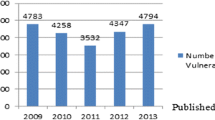Abstract
This article compares security fuzzing approaches with respect to different characteristics commenting on their pro and cons concerning both their potential for exposing vulnerabilities and the expected effort required to do so. These preliminary considerations based on abstract reasoning and engineering judgement are subsequently confronted with experimental evaluations based on the application of three different fuzzing tools characterized by diverse data generation strategies on examples known to contain exploitable buffer overflows. Finally, an example inspired by a real-world application illustrates the importance of combining different fuzzing concepts in order to generate data in case fuzzing requires the generation of a plausible sequence of meaningful messages to be sent over a network to a software-based controller as well as the exploitation of a hidden vulnerability by its execution.
Access this chapter
Tax calculation will be finalised at checkout
Purchases are for personal use only
Similar content being viewed by others
References
Al Sardy, L., Saglietti, F., Tang, T., Sonnenberg, H.: Constraint-based testing for buffer overflows. In: Gallina, B., Skavhaug, A., Schoitsch, E., Bitsch, F. (eds.) SAFECOMP 2018. LNCS, vol. 11094, pp. 99–111. Springer, Cham (2018). https://doi.org/10.1007/978-3-319-99229-7_10
Cadar, C., Dunbar, D., Engler, D.: KLEE: unassisted and automatic generation of high-coverage tests for complex systems programs. In: USENIX Symposium on Operating Systems Design and Implementation (OSDI 2008). USENIX Association (2008)
Cisco: Most Common CWE Vulnerabilities, annual cybersecurity report (2018)
Cisco: CWE threat category activity, midyear security report (2015)
Eddington, M.: Peach Fuzzer (2019). http://peachfuzzer.com/
Evans, D., Larochelle, D.: Improving security using extensible lightweight static analysis. IEEE Softw. 19, 42–51 (2002). https://doi.org/10.1109/52.976940
Makarov, A., Billowie, O.: Steuerung einer Destillationsanlage, interner Bericht. Hochschule Magdeburg-Stendal, Fachbereich IWID, Institut für Elektrotechnik (2008)
MITRE Corporation: A buffer overflow vulnerability in WhatsApp VOIP stack allowed remote code execution via specially crafted series of SRTCP packets sent to a target phone number, Common Vulnerabilities and Exposures Database (CVE), CVE-2019-3568 (2019)
MITRE Corporation: Buffer overflow in the skey_challenge function in ftpd.c for wu-ftp daemon (wu-ftpd) 2.6.2, Common Vulnerabilities and Exposures Database (CVE), CVE-2004-0185 (2004)
MITRE Corporation: Buffer overflow in the SockPrintf function in wu-ftpd 2.6.2, Common Vulnerabilities and Exposures Database (CVE), CVE-2003-1327 (2003)
MITRE Corporation: Off-by-one Error in fb_realpath(), Common Vulnerabilities and Exposures Database (CVE), CVE-2003-0466 (2003)
Oulu University Secure Programming Group (OUSPG): Radamsa (2010). https://www.ee.oulu.fi/roles/ouspg/Radamsa
Saglietti, F., Meitner, M., von Wardenburg, L., Richthammer, V.: Analysis of informed attacks and appropriate countermeasures for cyber-physical systems. In: Skavhaug, A., Guiochet, J., Schoitsch, E., Bitsch, F. (eds.) SAFECOMP 2016. LNCS, vol. 9923, pp. 222–233. Springer, Cham (2016). https://doi.org/10.1007/978-3-319-45480-1_18
Schneider Electric Software Security Response Center: InduSoft Web Studio and InTouch Machine Edition – Remote Code Execution Vulnerability, Security Bulletin LFSEC00000125 (2018)
Shahriar, H., Zulkernine, M.: Classification of static analysis-based buffer overflow detectors. In: 4th International Conference on Secure Software Integration and Reliability Improvement Companion (SSIRI-C). IEEE (2010). https://doi.org/10.1109/ssiri-c.2010.28
Shoshitaishvili, Y., Wang, R., et al.: (State of) the art of war: offensive techniques in binary analysis. In: IEEE Symposium on Security and Privacy. IEEE (2016)
Swiecki, R.: Hongfuzz (2018). www.github.com/google/hongfuzz
Zalewski, M.: American Fuzzy Lop (AFL) (2017). http://lcamtuf.coredump.cx/afl/
Acknowledgment
The authors gratefully acknowledge that part of the work presented was supported by the German Federal Ministry for Economic Affairs and Energy (BMWi), project SMARTEST.
Author information
Authors and Affiliations
Corresponding authors
Editor information
Editors and Affiliations
Appendix
Appendix

Code of example 5 (Turing machine)
Rights and permissions
Copyright information
© 2019 Springer Nature Switzerland AG
About this paper
Cite this paper
Al Sardy, L., Neubaum, A., Saglietti, F., Rudrich, D. (2019). Comparative Evaluation of Security Fuzzing Approaches. In: Romanovsky, A., Troubitsyna, E., Gashi, I., Schoitsch, E., Bitsch, F. (eds) Computer Safety, Reliability, and Security. SAFECOMP 2019. Lecture Notes in Computer Science(), vol 11699. Springer, Cham. https://doi.org/10.1007/978-3-030-26250-1_4
Download citation
DOI: https://doi.org/10.1007/978-3-030-26250-1_4
Published:
Publisher Name: Springer, Cham
Print ISBN: 978-3-030-26249-5
Online ISBN: 978-3-030-26250-1
eBook Packages: Computer ScienceComputer Science (R0)




